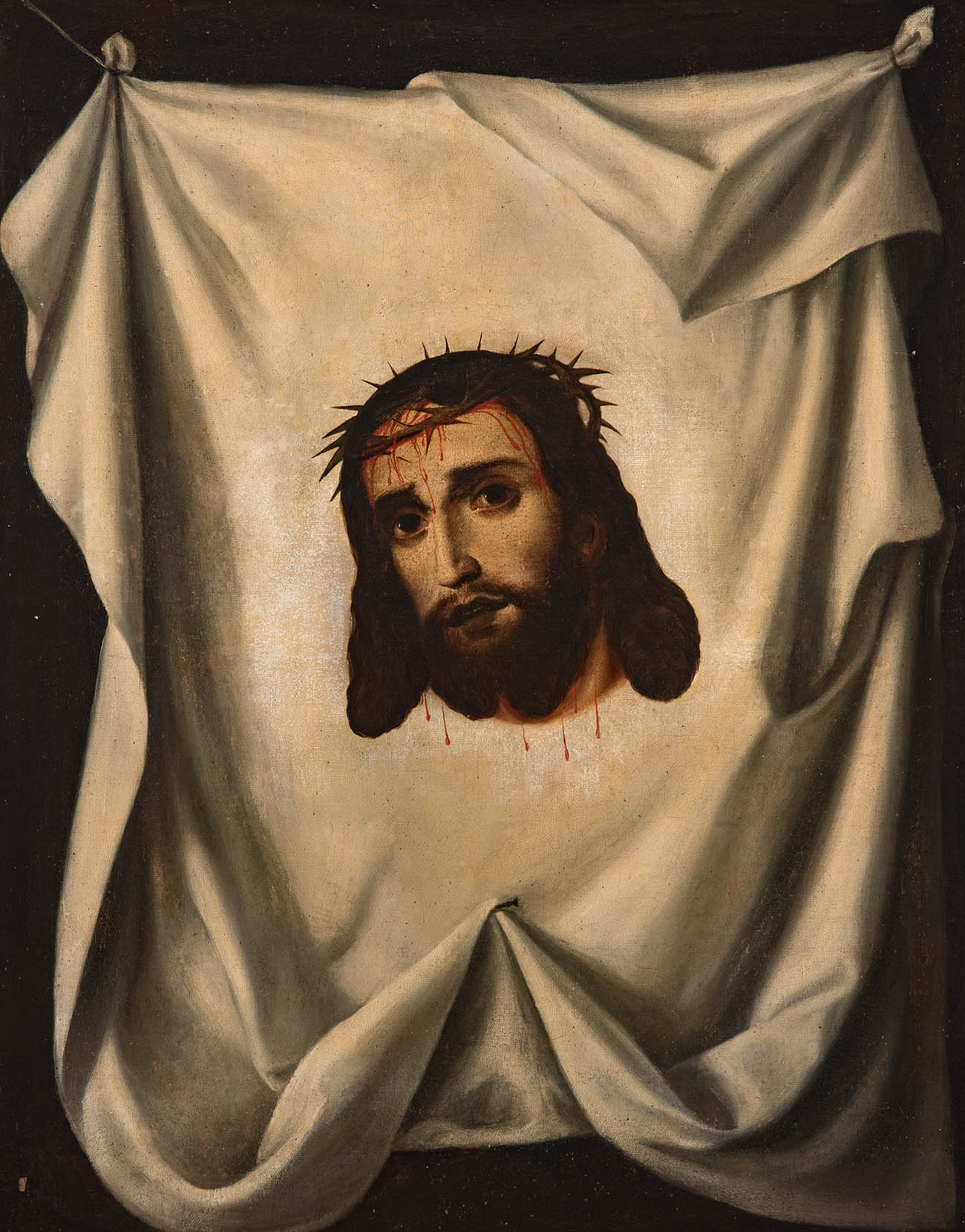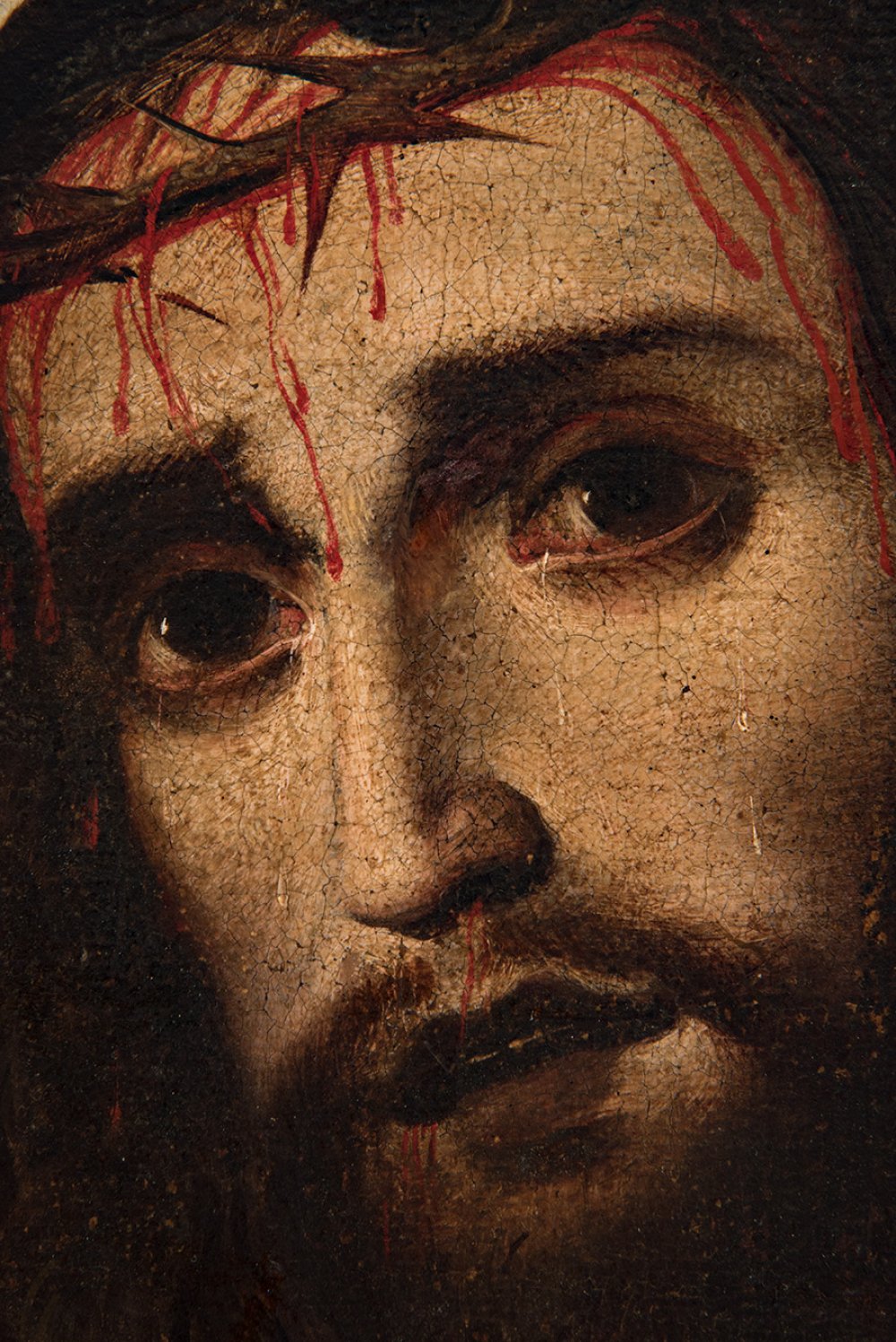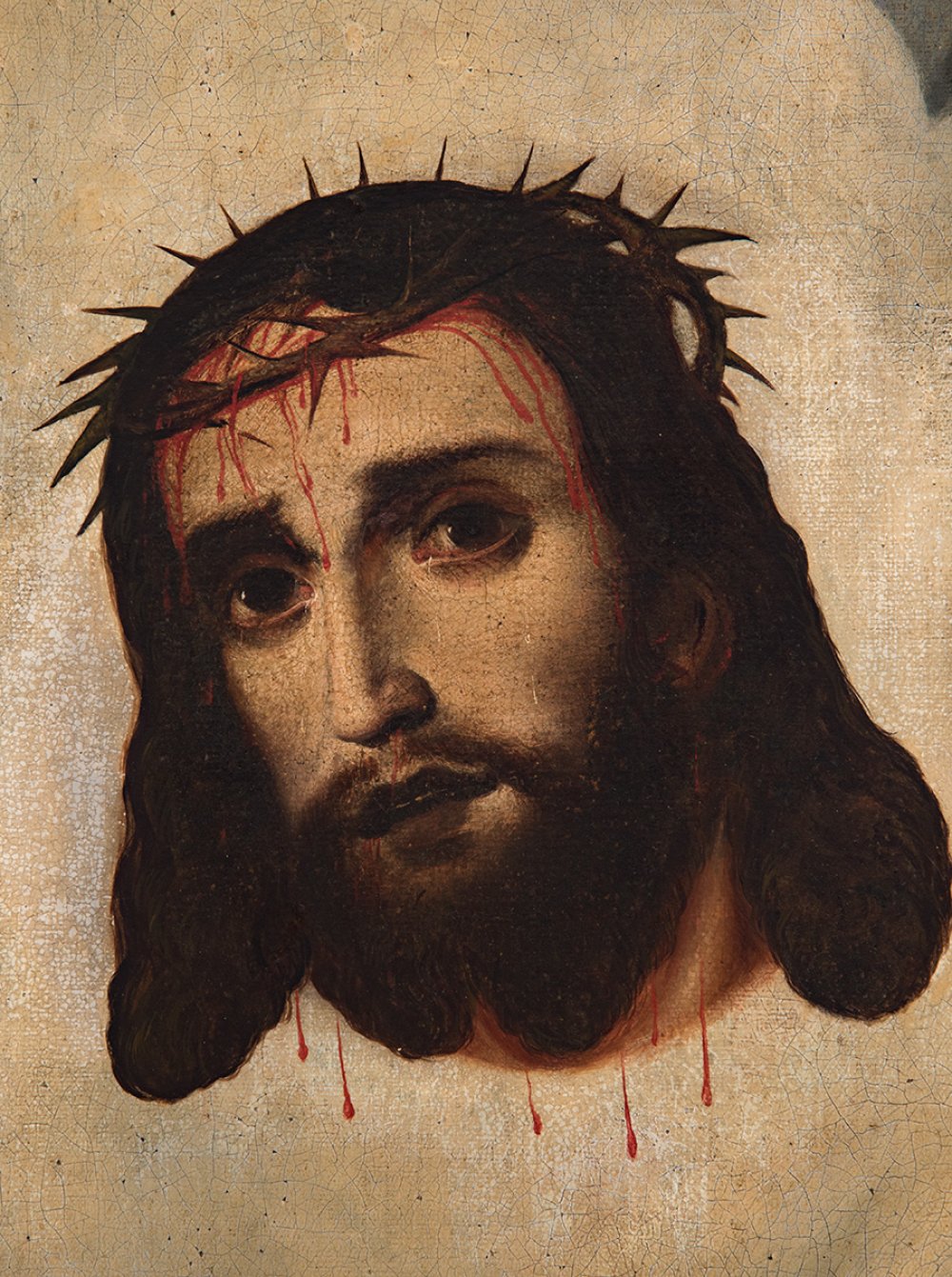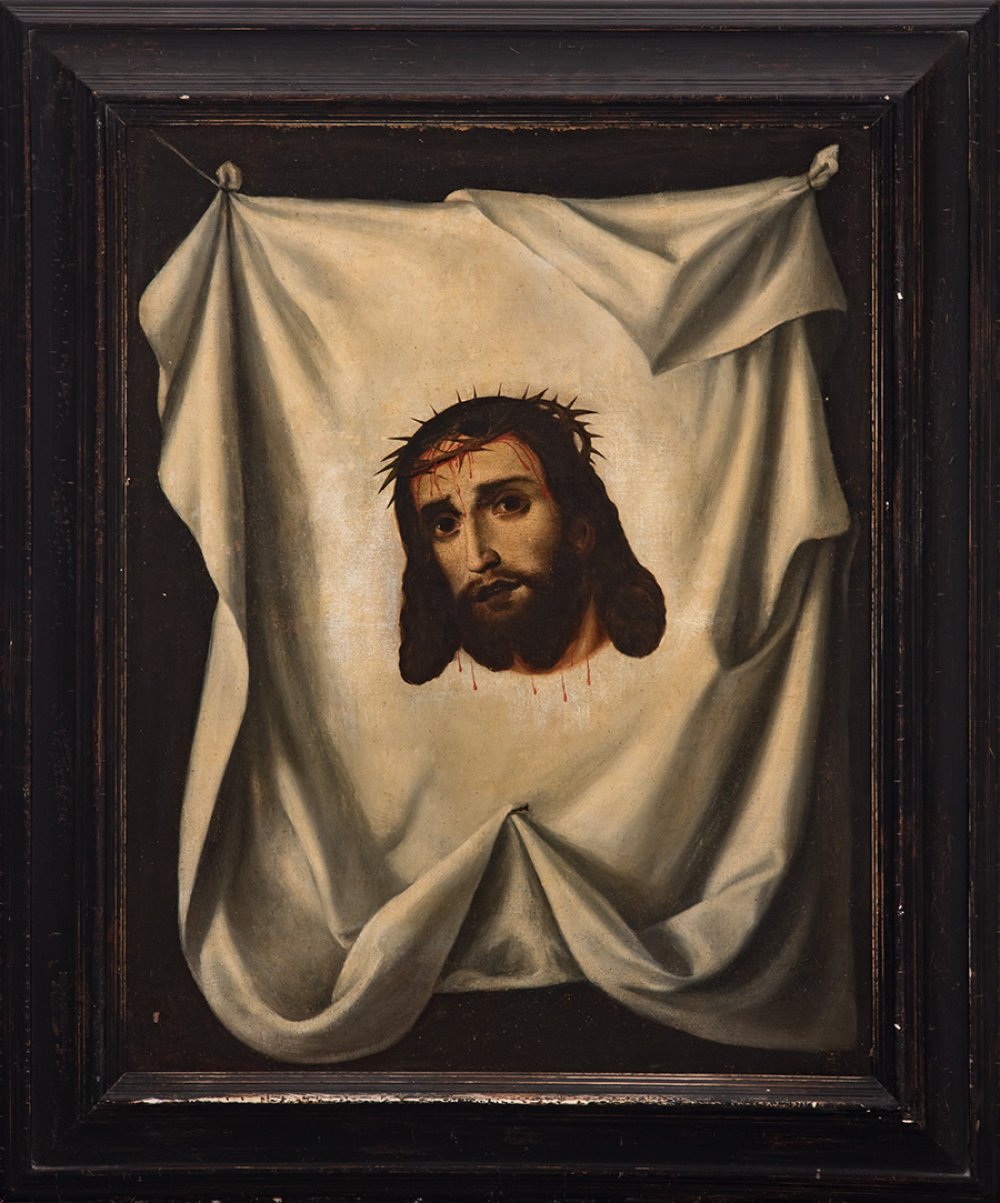4
School of FRANCISCO ZURBARÁN (Fuente de Cantos, Badajoz, 1598 - Madrid, 1664)."Santa Faz".Oil on
"Santa Faz".
Oil on canvas. Re-enteled.
It presents repainting.
Measurements: 73,5 x 59,5 cm; 94 x 78 cm (frame).
In this devotional image painted in oil on canvas, the image of Christ's face is represented, which seems to be printed on the canvas of the Veronica. Jesus wears the crown of thorns, and shows the blood stains that show suffering or exhaustion. Looking directly at the viewer with a serious and emphatic gesture, but at the same time serene and calm, the image thus reflects Christ as Saviour and Redeemer. The iconography of the Holy Face has its origins in the episode during the Passion of Christ, when on the way to Calvary a woman took off her veil to wipe the face of the Messiah with it. The image of the face of Jesus Christ was imprinted on the linen handkerchief, and it was miraculously preserved through the centuries and became an object of worship. The woman would later be called Veronica, whose etymology derives from the Latin "verum" (true) and the Greek "eikon" (image). The Holy Face is one of the most famous relics of Christianity, first described in 1137.
The subject of the Holy Face was taken up by Francisco Zurbarán at a time when works with this theme were no longer common. Francisco de Zurbarán trained in Seville, where he was a pupil of Pedro Díaz de Villanueva between 1614 and 1617. During this period he had the opportunity to meet Pachecho and Herrera and to establish contacts with his contemporaries Velázquez and Cano, apprentices like himself in Seville at the time. After several years of diverse apprenticeship, Zurbarán returned to Badajoz without undergoing the Sevillian guild examination. He settled in Llerena between 1617 and 1628, where he received commissions both from the municipality and from various convents and churches in Extremadura. In 1629, at the unusual suggestion of the Municipal Council, Zurbarán settled permanently in Seville, marking the beginning of the most prestigious decade of his career. He received commissions from all the religious orders present in Andalusia and Extremadura, and was finally invited to the court in 1934, perhaps at Velázquez's suggestion, to take part in the decoration of the great hall of the Buen Retiro. On returning to Seville, Zurbarán continued to work for the court and for various monastic orders. In 1958, probably prompted by the difficulties of the Sevillian market, he moved to Madrid. During this last period of his output he produced small-format private devotional canvases of refined execution. Zurbarán was a painter of simple realism, excluding grandiloquence and theatricality from his work, and we can even find some clumsiness when solving the technical problems of geometric perspective, despite the perfection of his drawing of anatomies, faces and objects. His severe, rigorously ordered compositions reach an exceptional level of pious emotion. With regard to tenebrism, the painter practised it above all in his early Sevillian period.
"Santa Faz".
Oil on canvas. Re-enteled.
It presents repainting.
Measurements: 73,5 x 59,5 cm; 94 x 78 cm (frame).
In this devotional image painted in oil on canvas, the image of Christ's face is represented, which seems to be printed on the canvas of the Veronica. Jesus wears the crown of thorns, and shows the blood stains that show suffering or exhaustion. Looking directly at the viewer with a serious and emphatic gesture, but at the same time serene and calm, the image thus reflects Christ as Saviour and Redeemer. The iconography of the Holy Face has its origins in the episode during the Passion of Christ, when on the way to Calvary a woman took off her veil to wipe the face of the Messiah with it. The image of the face of Jesus Christ was imprinted on the linen handkerchief, and it was miraculously preserved through the centuries and became an object of worship. The woman would later be called Veronica, whose etymology derives from the Latin "verum" (true) and the Greek "eikon" (image). The Holy Face is one of the most famous relics of Christianity, first described in 1137.
The subject of the Holy Face was taken up by Francisco Zurbarán at a time when works with this theme were no longer common. Francisco de Zurbarán trained in Seville, where he was a pupil of Pedro Díaz de Villanueva between 1614 and 1617. During this period he had the opportunity to meet Pachecho and Herrera and to establish contacts with his contemporaries Velázquez and Cano, apprentices like himself in Seville at the time. After several years of diverse apprenticeship, Zurbarán returned to Badajoz without undergoing the Sevillian guild examination. He settled in Llerena between 1617 and 1628, where he received commissions both from the municipality and from various convents and churches in Extremadura. In 1629, at the unusual suggestion of the Municipal Council, Zurbarán settled permanently in Seville, marking the beginning of the most prestigious decade of his career. He received commissions from all the religious orders present in Andalusia and Extremadura, and was finally invited to the court in 1934, perhaps at Velázquez's suggestion, to take part in the decoration of the great hall of the Buen Retiro. On returning to Seville, Zurbarán continued to work for the court and for various monastic orders. In 1958, probably prompted by the difficulties of the Sevillian market, he moved to Madrid. During this last period of his output he produced small-format private devotional canvases of refined execution. Zurbarán was a painter of simple realism, excluding grandiloquence and theatricality from his work, and we can even find some clumsiness when solving the technical problems of geometric perspective, despite the perfection of his drawing of anatomies, faces and objects. His severe, rigorously ordered compositions reach an exceptional level of pious emotion. With regard to tenebrism, the painter practised it above all in his early Sevillian period.
7th September - Old Masters
Sale Date(s)
Venue Address
General delivery information available from the auctioneer
Setdart offers Worldwide shipping
PICK UP IN ROOM: You can come and pick up your lots in our offices (Barcelona, Madrid or Valencia). At the moment of the withdrawal, you will be able to accept the current conditions of the lot by means of a document that you will sign.
YOU CAN SEND ANOTHER PERSON TO PICK UP: This person must present a signed authorization that you can find in our web page by accessing from BUY AT SETDART- LOGISTICS-DOWNLOAD AUTHORIZATION DOCUMENT. You can also send an e-mail with the requested data in AUTHORIZATION DOCUMENT to admin@setdart.com
Important Information
25% buyer´s premium
21% buyer´s premium at www.setdart.com
Terms & Conditions
The maximum period to pay the lots is 7 working days. You can pay either via bank transfer or with credit card through our platform www.setdart.com (we only accept VISA or Mastercard).
BUYER´S PREMIUM: 22% Hammer price + 21% VAT from the buyer´s premium
If your piece has more than 100 years, our Ministry of Culture requires an export certificate in order for the piece to leave the country. Note that if the piece goes inside the EU, there is no cost for the export certificate. If the piece goes outside the EU, there is a cost for the export certificate. You can find more information in our Ministry of Culture website: https://www.culturaydeporte.gob.es/en/cultura/patrimonio/exportacionimportacion/exportacion/tasas.html
INQUIRIES: admin@setdart.com
Setdart guides you through the entire process, from the time of award to the day you receive your lot. Our logistics team will be happy to manage your transport, and will advise you on the best shipping method with professionals from the sector used to handling works of art and jewelry.
WE OFFER WORLDWIDE DOOR TO DOOR SHIPPING
PICK UP IN ROOM: You can come and pick up your lots in our offices. At the moment of the withdrawal, you will be able to accept the current conditions of the lot by means of a document that you will sign.
YOU CAN SEND ANOTHER PERSON TO PICK UP: This person must present a signed authorization that you can find in our web page by accessing from BUY AT SETDART-LOGISTICS-DOWNLOAD AUTHORIZATION DOCUMENT. You can also send an e-mail with the requested data in AUTHORIZATION DOCUMENT to admin@setdart.com
SETDART IS NOT RESPONSIBLE FOR THE STATE OF THE PARTS ONCE THEY LEAVE OUR FACILITIES. MRW SHIPMENTS: Once the payment is made, your lot will be packed for shipment, the logistics department will send you an e-mail notifying you of the day it leaves our warehouse, changes of address cannot be made after receiving this e-mail.
INSURANCE INCIDENTS: Coverage for the value of the auction up to 3000 ? per shipment, if the value of the auction is higher, Setdart will send you a quote including the additional insurance. The insurance company WILL NOT BE RESPONSIBLE FOR THE SHIPMENT THAT EXCEEDS THAT AMOUNT AND IS NOT FULLY INSURED. MRW INCIDENTS: Maximum notification 48 hours after receipt, after which the insurance company WILL NOT BE RESPONSIBLE AND NO CLAIMS WILL BE ACCEPTED.
E-MAIL LOGISTICS: logistica@setdart.com
PICK UP YOUR MESSAGES: You can send your own messaging, prior notice via e-mail that your shipment is ready, please note 3 or 4 days in advance. This type of shipment is packaged so Setdart will provide you with a quote.
EXPENSES FOR STORAGE: We inform you that if the purchased lot is not picked up within a month, you will be charged 30€ per week per lot. Setdart Online S.L., owner of the web site "setdart.com", "setdart.net" and "setdart.org", acts as a company of Spanish nationality inscribed in the Volume 36955, sheet 182, page B-293056 of the Mercantile Registry, with registered office at Calle Aragó


















